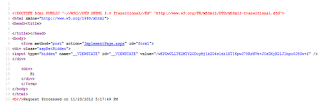Click to Download C# Example ImplementIHTTPModuleInterfaceInCSharp.zip
Click to Download VB.NET Example ImplementIHTTPModuleInterfaceInVBNET.zip
By Implementing IHttpModule interface we can plug classes into the request-processing pipeline. HTTP Module class do this by hooking into a application events as it processes the HTTP request.
To create an HttpModule, we simply create a class that implement the System.Web.IHttpModule interface.This interface requires you to implement Init and Dispose methods.
The Init method is the basic primary method. In this method we implement HttpModule functionality. You can register different events in to the Init method. Init method has a single parameter it's an object of HttpApplication class and it's name is "context".
To use this module, we must include the module in the request processing pipeline so that ASP.NET know that. We can do this to modify the web.config file.
For that you have to add an <httpModules> section to your web.config file.
Here is the generic format :
The generic format of the <httpModules> section is
If you want to deploy your application to an IIS 7 server, you must also add the module configuration to the
<system.webServer> configuration section.
If we create our HttpModule in the App_Code directory of an ASP.NET Web site. For that we use the text “App_Code” as the assembly name, which tells ASP.NET that module is located in the dynamically created assembly.
If we create HttpModules as a separate class library, in this case we use the assembly name of the library.
Here is example for this.
In this example we modify the HTTP output stream before it is sent to the client. This is very useful and simple tool if you want to add text to each page from your Web site, like a date/time stamp or the server name that processed the request, By doing this you do not modify each individual page in your application.
After creating class and register that module in web.config file execute your application and view any webpage you notice that at the end of content of web page there is one "Request Process on date/time" text. In the output you can view that source of generated HTML file.
Web.Confing Setting :
ASPX Code :
C# Examples :
VB.net Examples :
Output :
Output (HTML Source) :
Click to Download VB.NET Example ImplementIHTTPModuleInterfaceInVBNET.zip
By Implementing IHttpModule interface we can plug classes into the request-processing pipeline. HTTP Module class do this by hooking into a application events as it processes the HTTP request.
To create an HttpModule, we simply create a class that implement the System.Web.IHttpModule interface.This interface requires you to implement Init and Dispose methods.
The Init method is the basic primary method. In this method we implement HttpModule functionality. You can register different events in to the Init method. Init method has a single parameter it's an object of HttpApplication class and it's name is "context".
To use this module, we must include the module in the request processing pipeline so that ASP.NET know that. We can do this to modify the web.config file.
For that you have to add an <httpModules> section to your web.config file.
Here is the generic format :
The generic format of the <httpModules> section is
<httpModules> <add name="[modulename]" type="[namespace.classname, assemblyname]" /> </httpModules>
If you want to deploy your application to an IIS 7 server, you must also add the module configuration to the
<system.webServer> configuration section.
<modules> <add name="[modulename]" type="[namespace.classname, assemblyname]" /> </modules>
If we create our HttpModule in the App_Code directory of an ASP.NET Web site. For that we use the text “App_Code” as the assembly name, which tells ASP.NET that module is located in the dynamically created assembly.
If we create HttpModules as a separate class library, in this case we use the assembly name of the library.
Here is example for this.
In this example we modify the HTTP output stream before it is sent to the client. This is very useful and simple tool if you want to add text to each page from your Web site, like a date/time stamp or the server name that processed the request, By doing this you do not modify each individual page in your application.
After creating class and register that module in web.config file execute your application and view any webpage you notice that at the end of content of web page there is one "Request Process on date/time" text. In the output you can view that source of generated HTML file.
Web.Confing Setting :
<system.web> <httpModules> <add name="SimpleModule" type="SimpleModule, App_code"/> </httpModules> </system.web>
ASPX Code :
<form id="form1" runat="server"> <div> Hi </div> </form>
C# Examples :
public class SimpleModule : IHttpModule { private HttpApplication objApplication = null; public void Dispose() { } public void Init(System.Web.HttpApplication context) { objApplication = context; context.EndRequest += new EventHandler(context_EndRequest); } void context_EndRequest(object sender, EventArgs e) { string message = string.Format("<br/>Request Processed on {0}", System.DateTime.Now.ToString()); objApplication.Context.Response.Write(message); } }
VB.net Examples :
Public Class SimpleModule Implements IHttpModule Dim WithEvents objApplication As HttpApplication = Nothing Public Overridable Sub Init(ByVal context As HttpApplication) _ Implements IHttpModule.Init objApplication = context End Sub Public Overridable Sub Dispose() Implements IHttpModule.Dispose End Sub Public Sub context_EndRequest(ByVal sender As Object, ByVal e As EventArgs) Handles objApplication.EndRequest Dim message As String = String.Format("<br/>Request Processed on {0}", System.DateTime.Now.ToString()) objApplication.Context.Response.Output.Write(message) End Sub End Class
Output :
Output (HTML Source) :
 |
| (To view original image , click on image) |

No comments:
Post a Comment